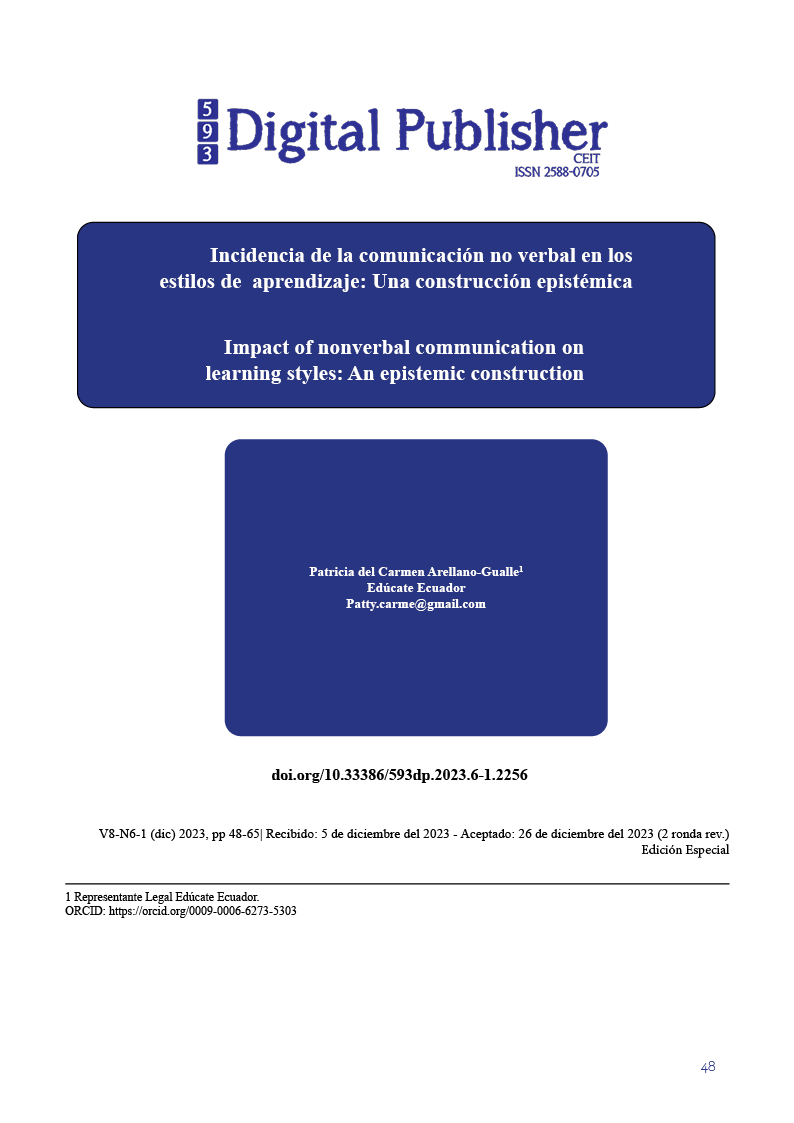Impact of nonverbal communication on learning styles: An epistemic construction
Main Article Content
Abstract
The basic intention of this scientific article is to build a didactic episteme from a methodical perspective, associated with the incidence of non-verbal communication in learning styles in the Technical Field and Human-Social Sciences careers, belonging to the University of the Armed Forces. -ESPE, Sangolquí Campus of Ecuador, during the 2022-2023 academic period. For this purpose, a mixed methodology was applied, establishing relationships of correspondence and complementarity between the findings of the positivist and interpretive naturalistic paradigm through a field, explanatory, correlational type study. The qualitative reports were contrasted with the calculations obtained through the SPSS statistical program, based on descriptive and inferential statistics. It is concluded that the non-verbal communication of the subjects involved in relation to learning styles is not statistically significant, however it allowed us to identify to which category level of the analyzed variables they belong; giving rise to the creation of an episteme from the method associated with the impact that the constructs that emerge from the study had.
Downloads
Article Details

This work is licensed under a Creative Commons Attribution-NonCommercial-ShareAlike 4.0 International License.
1. Derechos de autor
Las obras que se publican en 593 Digital Publisher CEIT están sujetas a los siguientes términos:
1.1. 593 Digital Publisher CEIT, conserva los derechos patrimoniales (copyright) de las obras publicadas, favorece y permite la reutilización de las mismas bajo la licencia Licencia Creative Commons 4.0 de Reconocimiento-NoComercial-CompartirIgual 4.0, por lo cual se pueden copiar, usar, difundir, transmitir y exponer públicamente, siempre que:
1.1.a. Se cite la autoría y fuente original de su publicación (revista, editorial, URL).
1.1.b. No se usen para fines comerciales u onerosos.
1.1.c. Se mencione la existencia y especificaciones de esta licencia de uso.
References
Alder, H., y Hether, B. (2000). PNL en sólo 21 días una completa introducción con su programa de entrenamiento. (Edaf, Ed.) Dialnet.
Alonso, C., Gallego, D. y Honey, P. (1997). Los estilos de aprendizaje. Procedimientos de diagnóstico y mejora. (8ª ed.). Bilbao, España: Ediciones Mensajero. Álvarez, A. (2012). La magia de la PNL: Comunicación, transformación y poder personal. EDAF.
Cerda, H. (2008). La investigación total. La unidad metodológica en la investigación científica. Colombia: Cooperativa Editorial Magisterio.
Domínguez López, E. (2015). Ciencia y complexus cultural: un ensayo. (Página web en línea). Consultado el 12 de Febrero de 2022. Disponible en: https://bioethics.miami.edu › pdf › lopez-ensayo.
Freire, P. (2002). Cartas a quien pretende enseñar. Editores Argentina.
Herrera Pavo, M.A. y Cochancela Patiño, M.G. (2020). Aportes de las reformas curriculares a la educación obligatoria en el Ecuador. Contributions of curricular reforms to compulsory education in Ecuador. Revista Scientific, vol. 5, Núm. 15, pp. (362-383). Instituto Internacional de Investigación y Desarrollo Tecnológico Educativo. [Consultado en Febrero de 2022]. Disponible en: https://www.redalyc.org/journal/5636/563662155020/
Birdwhistell, R. (1952). Introduction to kinesics. Department of State, Foreign Service Institute.
Baró, T. (2018). Inteligencia no verbal. Paidós.
Efron, D. (1970).Gesto, raza y cultura [1941]. Buenos Aires: Nueva Visión.
Entwistle, N., Karagiannopopoulou, E., Olafsdottir, A., Walker, P. (2016). Research into student learning and university teaching: changing perspectives. En J. Case and J. Huisman (Eds.) Researching Higher Education. International perspectives on theory, policy and practice (pp. 194-217). Oxon, UK: Routledge.
Hall, E. (1959). El lenguaje silencioso. Estados Unidos de América: Ediciones doubleday
Hernández Sampieri, C., Fernández Collado, P., Baptista L. (2014).Metodología de la investigación (6ª.ed.). España: McGraw Hill ·.
Herrera Pavo, M.A. y Cochancela Patiño, M.G. (2020). Aportesde las reformas curriculares a la educación obligatoria en el Ecuador. Contributions of curricular reforms to compulsory education in Ecuador. Revista Scientific, vol. 5, Núm. 15, pp. (362-383). Instituto Internacional de Investigación y Desarrollo Tecnológico Educativo. [Consultado en Febrero de 2022]. Disponible en: https://www.redalyc.org/journal/5636/563662155020/
Honey, P., y Mumford, A. (1992). The manual of learnig style. Peter Honey.
Macías, M. (2017). La comunicación no verbal desde la Programacion Neurolinguistca en la entrevista laboral. Repositorio Digital UEES. Obtenido de: http://repositorio.uees.edu.ec/bitstream/123456789/2331/1/MARIA%20DANIELA%20MACIAS%20RUGEL%20TESIS%20COMUNICACION%20NO%20VERBAL.pdf.
Mehrabian, A. (1971). Silent Messages. California: Wadsworth.
Pease, A. (2006). El lenguaje del cuerpo. España: Paidós.
Pérez Serrano, G. (2011). El conocimiento científico y sus carcomas. Teoría de la Educación. Revista Interuniversitaria, 23(2), 19-43.
Pons, C. (2015). Comunicación no verbal. Kairos S.A.
Prosser, M. (2010). Faculty research and teaching approaches: Exploring the relationship. En: J. Christensen-Hughes, and J. Mighty (Eds.), Taking Stock: Research on Teaching and Learning in Higher Education (pp. 129-137). Montreal, Canada: McGill-Queen’sUniversity.
Quintana, J. (2017). Evaluación del proceso de enseñanza y aprendizaje en la Universidad Pedagógica Experimental Libertador-Maracay: un enfoque epistemológico. Tesis doctoral, Universidad de Carabobo, Facultad de Ciencias de la Educación, Valencia-Venezuela.
Revista de Educación (1998). La educación venezolana. Laboratorio Educativo. Caracas, Venezuela.
Ruíz, O. (2019). Qué piensan los profesores universitarios de los estilos de aprendizaje. Unimagdalena.
Rulicki, S. (2011). Comunicación no verbal: cómo la inteligencia. Granica.
Sanz, G. (2005). Comunicación efectiva en el aula. Técnicas de expresión oral para docentes. Graó.
Vildózola Tibaud, X. (2009). Las actitudes de profesores y estudiantes y la influencia de factores de aula en la transmisión de la naturaleza de la ciencia en la enseñanza secundaria. Tesis doctoral. Facultad de Formación del Profesorado. Universidad de Barcelona, España.


